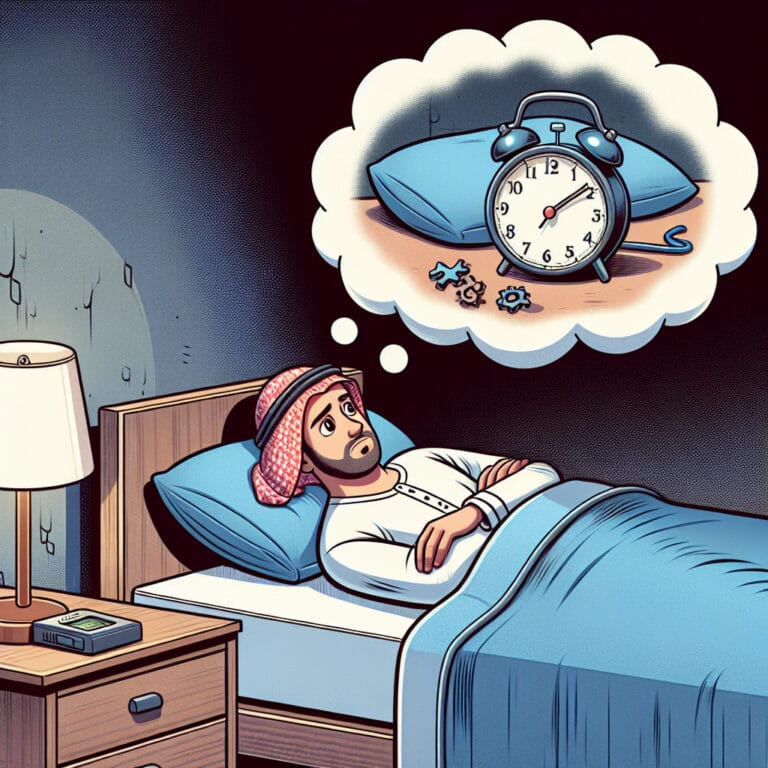
Understanding Sleep Restriction: Definition, Benefits and Strategies
Table of Contents
- Introduction
- Definition of Sleep Restriction
- Benefits of Sleep Restriction
- Strategies for Implementing Sleep Restriction
- Conclusion
- Frequently Asked Questions
Introduction
Employing sleep restriction therapy has unfolded significant advantages for those battling chronic insomnia and other sleep disorders. This behavioral treatment, a key component of cognitive behavioral therapy for insomnia (CBT-i), focuses on reducing time spent in bed not sleeping, thereby increasing the pressure to sleep and making the overall sleep time more efficient. It helps individuals fall asleep faster, stay asleep longer and enhances their quality of sleep. With this method, patients are guided by a certified sleep specialist to gradually adjust their sleeping window – the period set for uninterrupted rest – until it corresponds with their average total sleep time as reflected in their personal sleep diary. Notably, adult patients often report improved sleep efficiency after implementing these changes prescribed by insomnia CBT-i treatment options. Studies have shown that even older adults could find relief from persistent wakefulness during daylight savings time through careful circadian timing adjustments with such an approach. Remarkably acute effects can be seen within days; clinical effects such as reduced difficulty falling or staying asleep may gradually improve over weeks of consistent practice as part of an online CBT-i intervention program emphasizing optimal bedtime behavior and good sleep hygiene practices.
Definition of Sleep Restriction
Sleep restriction therapy, part of the broader cognitive behavioral therapy approach, is emerging as an effective treatment in sleep medicine for combating chronic insomnia and other sleep disorders. By reducing time spent in bed not sleeping, this targeted strategy increases sleep pressure – a beneficial build-up that aids both in falling asleep quickly and staying asleep longer. One key element of this process is the concept of ‘sleep window’, which refers to the designated period for uninterrupted rest. This window is carefully tailored by a sleep specialist based on an individual’s average total sleep time recorded in their personal sleep diary.
The beauty of this technique lies in its simplicity yet profound impact. Insomnia patients often find themselves trapped in detrimental cycles where they spend long hours tossing and turning without achieving quality sleep. Sleep restriction therapy breaks this cycle by limiting the duration spent trying to fall asleep, thereby maximizing the efficiency of actual sleep time.
What makes it even more effective is its compatibility with circadian timing – our biological clock that governs our natural wake-sleep cycle. For example, older adults who experience difficulty adjusting during daylight savings times can see improvements through precise circadian adjustments using insomnia CBT-i treatment options.
Increased sleep efficiency achieved through this method not only means better night-time rest but also leads to heightened daytime alertness and improved overall health. It’s worth mentioning here that while these acute effects are promising, consistency plays a critical role – clinical effects such as reduced difficulty falling or staying asleep can take weeks to observe as part of an online CBT-i intervention program.
In essence, whether you are an adult patient battling chronic insomnia or simply someone seeking better quality nighttime rest, implementing strategies like keeping good sleep hygiene practices along with following a regularized schedule prescribed by your trusted insomnia specialist can lead to significantly improved outcomes with your overall journey towards obtaining efficient quality snooze time.
| Term | Description |
|---|---|
| Sleep restriction therapy | A technique that forms part of cognitive behavioral therapy and is used to treat chronic insomnia and other sleep disorders. It works by reducing the time spent in bed not sleeping, thus increasing sleep pressure which aids in falling asleep quickly and staying asleep longer. |
| Sleep window | The designated period for uninterrupted rest which is tailored by a sleep specialist based on an individual’s average total sleep time recorded in their personal sleep diary. |
| Circadian timing | Our biological clock that governs our natural wake-sleep cycle. Sleep restriction therapy is compatible with circadian timing, meaning it can be used to make precise adjustments to help individuals, particularly older adults, adjust to changes like daylight savings times. |
| Insomnia CBT-i treatment | A treatment option that allows for precise adjustments to the circadian timing. It can be particularly effective for older adults struggling to adjust to daylight savings times. |
| Sleep efficiency | The quality of sleep achieved, which can be improved through sleep restriction therapy. Increased sleep efficiency can lead to better night-time rest, heightened daytime alertness, and improved overall health. |
| Online CBT-i intervention program | A program where clinical effects such as reduced difficulty falling or staying asleep can take weeks to observe. Consistency in this program is key to observing promising results. |
| Sleep hygiene practices | Strategies implemented to improve the quality of sleep, often used in conjunction with sleep restriction therapy. They can be particularly effective when prescribed by a trusted insomnia specialist as part of a regular schedule. |
Benefits of Sleep Restriction
Pioneering a new wave in sleep medicine, sleep restriction therapy proves to be an effective treatment for chronic insomnia and a range of other sleep disorders. This behavioral treatment works by lessening the time spent in bed without falling asleep, thereby augmenting the body’s natural sleep pressure. This unique mechanism aids individuals not just to fall asleep but also enhances their ability to stay asleep. A well-regulated sleep schedule under this therapy is shown to increment average total sleep time, leading to quality sleep that most individuals long for.
Complementing these benefits are findings from numerous scientific studies validating both acute effects and extended clinical effects of such treatments. Short-term improvements can often be observed within days as patients find it easier to drift into restful slumbers. The long-term benefits unfold gradually over weeks with consistent practice, resulting in reduced difficulty falling or staying asleep – a significant triumph for many insomnia patients.
For older adults who face persistent wakefulness during daylight savings time, this cognitive behavioral therapy serves as an absolute game-changer. By enabling precise adjustments based on circadian timing, it helps them adapt seamlessly whilst increasing their overall sleep efficiency.
The role of a trusted sleep specialist remains pivotal throughout this process; they curate individualized plans based on personal factors like average total sleep time logged in one’s sleep diary and specific needs reflected by their treatment options preference.
Interestingly, adult patients have also reported improved daytime alertness post implementing this therapy – an attestation of how refined sleeping patterns can lead to enhanced mental clarity and heightened productivity levels during awake hours.
In essence, whether you’re battling chronic insomnia or simply seeking better night-time rest, consider trying out insomnia CBT-i facilitated by trained professionals offering online intervention programs tailored just right for you!
Strategies for Implementing Sleep Restriction
Embracing sleep restriction therapy unveils a myriad of benefits, particularly for those grappling with chronic insomnia and various sleep disorders. This innovative approach in sleep medicine involves a reduction of time spent dwelling on elusive slumber, thereby amplifying the body’s natural urge to fall asleep. The result? A profound ability to not only drift into peaceful rest but also to stay asleep for longer periods. Following this new path in your bedtime routine enhances your overall quality sleep by aligning your sleep schedule with your average total sleep time logged in a personalized sleep diary. The magic doesn’t stop there – even older adults struggling with persistent wakefulness during daylight savings times find solace through this effective treatment as it accommodates precise adjustments based on individual circadian timing.
While short-term effects such as improved daytime alertness are often realized within days, extended clinical effects like reduced difficulty falling or staying asleep unfold gradually over weeks of consistent practice. Guided by a qualified sleep specialist, insomnia patients hone their behavioral treatment techniques which include maintaining stringent sleep hygiene practices and managing their unique ‘sleep window’. In today’s digital age, tailored online CBT-i intervention programs add an additional layer of flexibility and accessibility making insomnia CBT-i an appealing option for many seeking better night-time rest. Indeed, the benefits reaped from regularized implementation of these treatment options are a testament to how beneficial it is to invest in achieving improved sleep efficiency.
| Strategy | Description | Benefits |
|---|---|---|
| Sleep Restriction Therapy | A reduction of time spent trying to sleep, increasing the body’s natural urge to fall asleep | Ability to fall asleep faster and stay asleep for longer periods |
| Aligning Sleep Schedule | Aligning sleep schedule with average total sleep time logged in a personalized sleep diary | Enhances overall quality of sleep |
| Adjustment Based on Circadian Timing | Adjusting sleep schedule based on individual circadian timing, particularly effective during daylight savings times | Helps older adults struggling with persistent wakefulness |
| Behavioral Treatment Techniques | Techniques guided by a qualified sleep specialist, includes maintaining stringent sleep hygiene practices and managing a unique ‘sleep window’ | Reduced difficulty falling or staying asleep, improved daytime alertness |
| Online CBT-i Intervention Programs | Digital programs that add an additional layer of flexibility and accessibility | Makes insomnia CBT-i an appealing option for many seeking better night-time rest |
Conclusion
Harnessing the power of sleep restriction therapy can be a game-changer in tackling chronic insomnia, offering respite to patients tired of restless nights. This innovative technique in sleep medicine focuses on limiting time spent in bed not sleeping, thereby amplifying the body’s inherent sleep pressure and helping individuals fall asleep faster and stay asleep longer. Armed with their own sleep diary, they work hand-in-hand with a trusted sleep specialist to tailor an effective treatment plan that aligns their sleep schedule with their average total sleep time. Cognitive behavioral therapy techniques are employed further to enhance the overall quality of restful slumber achieved. For older adults struggling with the unsettling changes brought by daylight savings times, this method presents a beacon of hope as it allows for precise circadian timing adjustments resulting in improved sleep efficiency and heightened daytime alertness – all while challenging prevalent misconceptions about spending more time in bed equating to better rest. The growing popularity of online CBT-i intervention programs has only made access to this powerful tool more accessible than ever before. Whether you’re battling persistent insomnia or simply seeking enhanced night-time rest, remember that achieving quality snooze time is just a few dedicated steps away!



